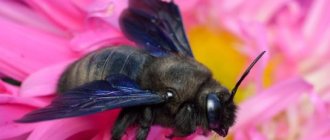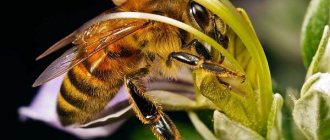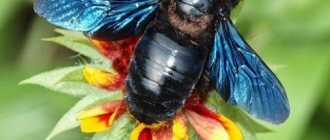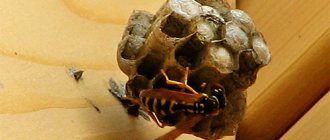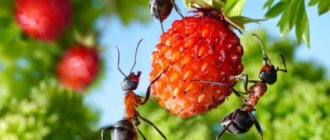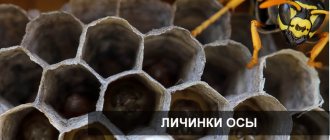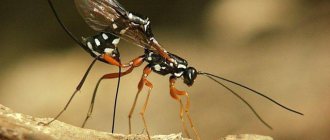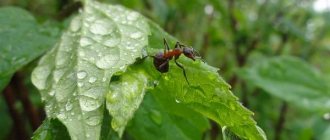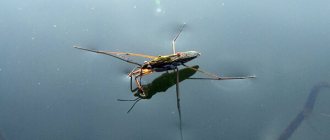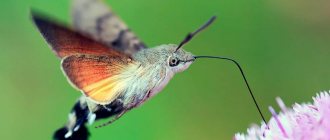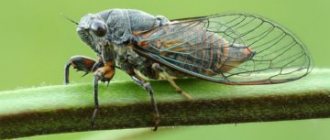Features and habitat
Bees are flying insects that are distantly related to wasps and ants. There are about 520 genera recorded, which include about 21,000 species, which is why there are so many insects similar to bees.
These arthropods have an extremely wide distribution - they are found on all continents, with the exception of cold Antarctica. The “head” of the insect is crowned with antennae, divided into 13 or 12 parts (in males and females, respectively), and a long thin proboscis, which is used for obtaining food.
Almost all types of bees have 2 pairs of wings, however, there are some species whose wings are so small and weak that they cannot fly. The size of an adult varies from 2 mm to 4 cm, depending on the species.
A bee is an extremely useful insect that takes a direct part in the process of flowering and reproduction of plants, collecting nectar and pollen. The body of the insect is covered with villi, to which pollen sticks; when a certain amount has accumulated, the bee transfers it to a basket, which is located between the hind legs.
Some species of bees prefer pollen from one plant, others are guided only by the presence of this substance, regardless of the source. Bees are often used to increase the number of flowers, however, wild members of the family live far from humans and their possessions. Such bees, along with other insect pests, are dying due to human extermination programs.
In addition, bee colonies are disappearing due to the treatment of cultivated plants with pesticides and the reduction of plantings of honey plants due to the growth of cities. Extinction is gaining momentum every year; there is an opinion that if no measures are taken to preserve the size of the family, bees will disappear in the 2030s.
Needless to say, this promises a complete loss of honey for humans, as well as a huge reduction in the number of flowers, fruits and vegetables. You can help domestic bees by planting more honey-bearing plants near the hives for insects, and refusing to treat the garden with chemicals.
Is a bee an insect or not?
According to biological typology, the bee (lat. Anthophila) belongs to the kingdom Animals, phylum Arthropods and class Insects, superfamily Bees. Its closest relatives are the wasp and the ant.
Evidence that a bee is an insect is provided by the signs found in it that are characteristic of these creatures:
- a body consisting of three sections: head, chest and abdomen;
- the presence of antennae;
- compound eyes;
- the body has several pairs of legs;
- presence of wings.
Important! It is worth clarifying that some insects (for example, ants) do not have wings; they lost them in the process of evolution as unnecessary.
From the point of view of man breeding honey-bearing creatures for profit or benefit, it is appropriate to say that the bee is also a pet.
Character and lifestyle
Bees are social insects with a highly organized life. Together they obtain food and water, protect and guard the hive. In any group there is a strict hierarchy in which each level performs certain functions. The number of individuals may vary; the more bees there are in a group, the more differences appear between representatives of different levels of the hierarchy. Each structure has a uterus.
In the photo there are bees and a queen bee
Representatives of some groups are solitary bees. This means that in a given species there is only one type of female, and each performs the same functions - collecting pollen and storing food, and also reproducing.
Most often, such species do not produce honey, but their function is different - they collect pollen and nectar only from their “favorite” plants, that is, if the bees die, then the plant will disappear.
Females of solitary bees, for example, a black insect similar to a bee (the carpenter bee), often lay eggs in one hole in order to take turns guarding it, this lifestyle is usually called “communal”. But, each bee cares and fills only its own cell.
Representatives of some families cannot obtain food for themselves due to the lack of special devices, so they are forced to take food and lay eggs in other people's hives. Bees belonging to this species are often called “cuckoo bees.”
Honey bees form huge families. Typically, a family includes one queen, several thousand working females, and in the summer also several thousand drones (males). Alone, they will not survive and will not be able to create a new family.
general characteristics
The bee's head has a very mobile articulation with the chest. The eyes are complex and large. Along with them, most Hymenoptera have simple eyes (the bee has three). On the head there are variously arranged antennae. Most species have mouthparts of the gnawing type, while bees have a gnawing-licking type. Female Hymenoptera have an ovipositor, which is converted into a sting in bees.
Order Hymenoptera
Most hymenoptera have worm-shaped larvae, and they lack eyes and legs, and the head is poorly developed. Only the larvae of certain species of insects of this order have 3 pairs of thoracic legs and 6-8 pairs of abdominal legs.
Hymenoptera have a very well developed suprapharyngeal ganglion, or brain, and therefore they are characterized by complex behavior and the formation of conditioned reflexes.
Hymenoptera are especially important as plant pollinators. Among these insects, many are useful to humans (honey bees, ichneumon fly, etc.). However, there are many harmful species (sawflies, gall moths, etc.).
Reproduction and lifespan
In spring, one queen bee can lay up to 2,000 eggs daily. During honey collection, their number decreases to one and a half thousand pieces. Representatives of different ages fulfill different obligations, thus, having seen a bee in the photo , one can draw a conclusion about its status and the number of days lived, depending on the task that it performs.
In the photo there are bee larvae
Young insects that have lived less than 10 days feed the queen and all larvae, since young individuals secrete milk best. Around the 7th day of life, the first waxy secretions appear in the bee's abdomen and it begins to engage in construction.
In the spring you can see a lot of honeycombs that have just appeared - the bees that managed to survive the winter reach the “builder age” then. After 2 weeks, the wax glands stop working and the bees have to fulfill other obligations - cleaning the cells, cleaning and taking out garbage. However, after just a few days, the “cleaning ladies” are actively ventilating the nest. They carefully monitor that enemies do not approach the hive.
In the photo there is a bee and a honeycomb
The next stage of bee maturation is honey collection (20-25 days). In order to explain to the sisters where the most suitable flowers are located, the insect resorts to visual biocommunication.
Bees that have reached 30 days collect water for the entire family. This work is considered the most dangerous, since many individuals die near water bodies and other sources of moisture; in hot weather, a large number of birds, animals and other dangerous insects gather there.
Thus, the organization of the life of bees is aimed at the rational distribution of functions. The available individuals do business inside, the rest do business outside. Life expectancy depends on the species. The lifespan of honey bees is up to 10 months, but the meadow bumblebee lives only 1 month.
Photo of bees at a watering hole
bumblebees
The bumblebee (photo below) differs from the bee in its thick body, which is covered with hairs, and its large size. It has a bright, beautiful color. Females are larger than males. An insect carries an amount of pollen equal to its weight. Bumblebee larvae are fed with nectar and honey, which they make themselves.
It is thinner than bee, lighter, lighter and not as sweet and fragrant. Only the queen bumblebees remain for the winter. In the spring, they make small honeycombs in the ground and raise worker bumblebees. All subsequent work is done only by working individuals, the uterus is freed for laying eggs. By the autumn period, drones and young queens are born in the nest. After the mating period, the drones die, and the queens find shelter for the winter. Bumblebees (photo above) are excellent pollinators of various plants, and they are especially attracted to fields with clover. Knowing this, agricultural workers install small boxes along the edges of the fields where bumblebees could build nests.
Bee sting, is it dangerous?
Regardless of the species, bees are afraid of sudden movements, noise, loud sounds, and unpleasant odors. The aromas of perfume, the smell of sweat, garlic and alcohol irritate the bees; they are forced to sting in the same way as when waving their arms and running away.
Not many people know the fact that a bee dies immediately after being stung. This is explained by the fact that when bitten, the jagged sting remains deep under the skin of a person or animal. Trying to quickly fly away, the sting comes off along with most of the insect's intestines, causing the bee to die.
Immediately after a bee sting, you must immediately remove the sting from the sting site, otherwise strong bee venom will begin to penetrate the body and blood, causing severe swelling and an allergic reaction. Then the wound should be washed and treatment should begin.
Protection from enemies
There are interesting facts that distinguish domestic bees from wild ones. This is their ability to defend themselves. Wild bees stop buzzing when the hive vibrates. Being disturbed, the bee returns to the honeycomb and makes a quick run; the surface of the honeycomb is immediately covered with many bees. A few moments later they fall off the honeycomb and fly away in groups in pursuit of the aggressor. Not finding the enemy, they can stop the chase, but if one of them sticks a sting into him, then the bee venom spreading in the wind serves as a guide for the bees, and they quickly head to the right place. Bees living in hives are less aggressive, they are either accustomed to people or belong to a more peaceful lineage created as a result of domestication.
The honey bee has only one weapon against dozens of enemies; having stung cattle or humans, it immediately dies, since its stinging apparatus remains in the enemy’s body.
However, if a hornet or an ordinary wasp tries to attack it, having stung them, it can easily return its sting to its original place. Enemies often lie in wait for bees when they return to the hive with nectar or pollen. They catch them and take them to the nest to feed the larvae.
Himalayan
Himalayan bees
Himalayan hymenoptera bees are distinguished by their bright yellow and black coloration. These bees live in mountainous areas. These insects have a peaceful nature. Honey from Himalayan bees has hallucinogenic properties. This is because there are many rhodogendrones growing in the mountainous areas. Andromedotoxin, which is released by plants during the flowering period, is considered a powerful poison. When it enters the human body in small quantities, it provokes hallucinations.
Where do they live?
A valuable species is the honey bee, which is very rare today. Many individuals live in Bashkiria; a lot of work is being done to preserve this species: entire reserves are being built with an abundance of hollow trees, which ensures the survival of bees.
As a rule, bees settle in tree hollows, but often in practice it turns out differently. The main condition is the presence of a spacious place, protected from direct sunlight and strong winds. It is very important that there is a body of water nearby. For this reason, bees are often found in rock or earthen crevices.
Over time, wild bees chose to settle next to people, which is why insects often choose an attic, a secluded corner in a barn or garage for their home.
Useful properties of honey
The beekeeping product collected from wild honey plants is environmentally friendly. It is highly valued for its unique healing properties.
Collection is made once a year. By the end of summer, honey finally ripens and matures. Excess moisture goes away.
The product has a dark color, thick consistency, and a strong honey aroma. The taste is a little bitter. Does not crystallize for a long time. Due to its composition, it is used in both folk and traditional medicine.
Trees for real beekeeping are very rare. The bulk of the population lives today in Bashkiria. Only in the forests of this republic is wild honey produced in large quantities.
Beekeepers are professionals who collect honey reserves without causing harm to families. The usual volume of product from one nest is 1 kg, more is very rare.
How to fight
Wild bees settle in forest areas. Nests also appear near human habitation. Such a neighborhood frightens people because they are aggressive in nature.
You can get rid of “neighbors” in different ways:
- Protect the area from insects with a high fence. Flying over a large barrier is very tiring for wild honey plants; they will look for a more accessible place to “work.”
- Lavender bushes planted on the site will protect the area from uninvited guests.
- Fumigating indoors and outdoors with herbs with a strong aroma (mint, oregano, sage) will drive away unwanted neighbors.
- You can get rid of the swarm by handing it over to a beekeeper. The beekeeper will help catch the family and move it to a sufficiently distant distance from the old place.
- Earth species do not cause any harm. If the nest interferes with planting work, it is poured with boiling water or treated with pesticides.
In order to preserve the population of honey bees, wild bees were included in the Red Book. They disappear. By protecting the gene pool of insects, an important niche in the planet’s ecosystem is preserved, and people use the unique product of bee activity - honey.
How to catch
For breeding honey plants, the most important thing is to provide them with their usual “housing”. They choose trees and build hollows. You can prepare decks.
You can catch a family in different ways:
- During swarming, specially prepared traps are installed. Place them in a quiet, secluded place on a tree.
- After smoking out the inhabitants of the nest, the honeycombs with brood are collected and placed in a new nest.
- A labor-intensive method is cutting out a hollow tree.
Fishing technique
Traps for catching swarms are made of simple plywood. Frames are placed inside. No more than 8 pieces. For bait they put one or two old ones, the rest can be simply tied with wire. A free space of 2 cm is left between the bottom of the box and the honeycombs.
The trap is fixed with ropes and slings closer to the crown at a height of 5 meters. It is better to choose trees near a clearing or clearing. The box is checked every 7 days. The swarming period lasts from late May to July. If a swarm has settled in a trap, it is lowered from the tree and transported.
The trap is removed after sunset when the bees return. Carefully, without making too much noise, the beekeeper climbs the tree and closes the valve. It must be secured to prevent accidental opening during transport. When organizing the descent, you need to take into account that the weight of the temporary hive will be more than five kilograms.
Taming
Forest beekeeping is the breeding of insects in natural conditions. This work requires experience and knowledge. Families are fed regularly. Provide fresh water. If they are left to live in the hives, then insulation for winter is mandatory.
Taking honey from wild bees is dangerous! You cannot do this yourself without the help of an experienced beekeeper.
Interesting Facts
- a bee can drag a load that is 320 times its weight if the surface is rough;
- old bees in the hive die only in winter; in summer, sensing death, they fly away from the hive and die in the wild;
- the queen bee will never sting a person, but when she meets a rival, she uses her sting;
- in the southern United States and Mexico they feast on honey ants. Their abdomens contain sweet nectar that resembles honey. Hard-working ants specially look after such individuals so that in difficult times they can lick a secret that has a sweet taste from them. And in Thailand you can buy ant larvae on market stalls. They contain a lot of protein and are valued by local residents;
- By nature, wasps have powerful jaws. With their help, insects eat plant food and kill prey. Thus, hornets successfully crush the chitinous coverings of cockroaches and mantises with their strong jaws.
Appearance
Wild honey plants and domestic workers have a lot in common. But species bred by nature differ from those selected even externally:
- The first difference is color. Wild individuals are distinguished by monochromatic, discreet colors. Muted tones. Household “workers” are very smart and bright.
- Size. Selected breeds are much larger than their forest relatives.
- Wild individuals have a protective shell on their chest.
- The front pair of wings is longer than the back. Thick hair coat protects from cold.

